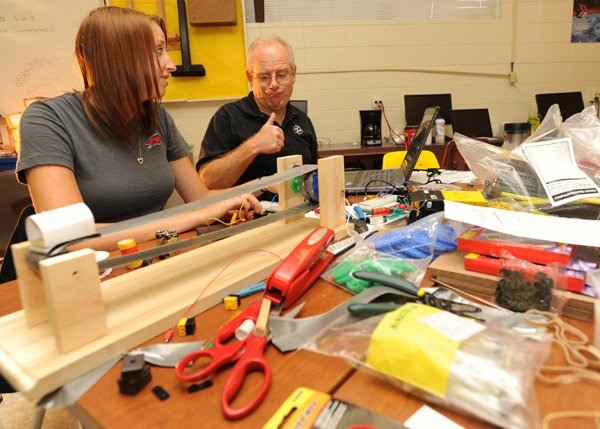FAYETTEVILLE — Teachers found the tables turned this week when they field-tested several projects for ninth- and 10th-grade students. The projects might find their way into Arkansas classrooms in the next couple of years.
The field testing, which included teachers from Springdale, Fayetteville, Arkadelphia and Bryant, is part of a curriculum development effort to offer a new program of study in career education, said Bruce Lazarus, education and instruction manager at the Arkansas Department of Career Education.
Innovations in Science and Technology is a four-year program for students interested in engineering and technology and is part of Gov. Mike Beebe’s initiative to introduce more STEM education in Arkansas. STEM is an acronym for science, technology, engineering and mathematics.
Each of the five teachers was given problems during the threeday trial, developed by a pair of University of Arkansas professors, and asked to solve the problem using equipment readily available in the classroom and at stores, such as Walmart or Home Depot. Some computer equipment was made available.
Claire Small, a Springdale High School teacher, created a contraption out of pieces of cardboard, masking tape, three wood dowels less than an inch thick, a stack of 2-inch mirror tiles and a laser pointer. Small, who teaches a pre-engineering program called Project Lead the Way, created a perimeter security system to “alert people” of a perimeter breach caused by the legendary Sasquatch.
Small chuckled when she outlined her problem. She continued to try to set the mirrors in a position to reflect the laser beam around a perimeter so it would sound an alarm and set off a small motion detector if the perimeter was breached.
Can a ninth-grader create a similar system in a classroom setting?
“I think so,” Small said, without looking up from the problem at hand. She said educators often underestimate what students can do.
Bethany Pommier, an engineering and technology teacher at Fayetteville’s Ramay Junior High School, worked on a pulley system to move the mail from the street to Grandma’s house. Grandma, according to the problem, is housebound and wants to get her mail when it is delivered at 10:30 a.m., rather than waiting until a grandchild arrives after school at 3:30 p.m.
Pommier built the system with a small craft motor, plastic gear, wooden dowels and a bike innertube. A small paper mailbox, about the size of a man’s thumb, was mounted on the innertube. As she studied the problem, she substituted a strip of silver masking tape to move the mailbox from the makebelieve street to the house.
“I think it’s fun,” Pommier said. “There are so many ways to do this. It’s all handson.”
A student would research postal laws, calculate the weight of magazines and measure the height of the front porch and door knobs to create a solution.
“This is true project-based learning,” Lazarus said. Students will have to draw on their core subjects to develop solutions to the problems. There are no right or wrong answers, he said.
The curriculum, once developed, aligns academic coursework and career education. The curriculum aims to excite students about their education.
“They can better understand why they are learning math concepts or science concepts,” Lazarus said.
The curriculum developed from the field testing shows expensive laboratories aren’t needed to solve the problems.
“Consumables can be purchased at Walmart, Home Depot or Lowe’s,” Lazarus said.
Michael Daugherty, professor of technology and engineering education, and Vinson Carter, clinical instructor of technology and engineering education, developed the problems. The pair has spent the past two years working on the project as part of a joint venture with the state Career Education Department, the Southern Regional Education Board in Atlanta and National Instruments, a Texas-based company. The Southern Regional Education Board and the Career Education Department provided the topics under which the problems have been developed.
Students will have four to six weeks to solve a problem by constructing a technological solution and demonstrating that solution in teams of two.
Five teachers will be selected to field-test the problems this fall in their classrooms. Lazarus said those teachers haven’t been selected.
After the curriculum is written and the field testing phase is completed, the curriculum should be ready to roll out for the 2013-14 school year when schools can sign up to off er the program to ninth- through 12th-grade students.

